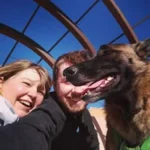Last updated: June 16, 2021
Everyone’s favorite topic, right?
And by “everyone” I of course mean no one. But it’s gotta be done – and it doesn’t have to be complicated or scary. With the strategy I’m about to teach you, it’s actually pretty simple.
Before we get started, there are a couple of things we need to get out of the way first:
1. Yes, you CAN house train your dog. It takes some commitment, but so does anything that’s worth doing, right? Take a deep breath. I believe in you.
2. There WILL be accidents in the house. It’s not the end of the world, it doesn’t mean that you have a bad dog, and it doesn’t mean you’re a bad owner.
The formula for successful house training:
Prevent unwanted behavior (eliminating indoors) and reward good behavior (eliminating outdoors).
Yup. That’s about it. And notice I said unwanted behavior, not bad behavior. Because your dog has no clue that she shouldn’t pee in the house. She’s not being “bad” on purpose.
Prevent unwanted behavior: crate training and management
Letting an un-potty-trained dog roam unsupervised in your house is like letting an un-potty-trained toddler roam free without a diaper. Sooner or later, there’s gonna be a mess.
When your dog (or uh, toddler?) is inside the house, she needs to be watched carefully to make sure she doesn’t go where she shouldn’t. We’re trying to prevent bad habits from forming (or if Sparky is already eliminating inside, stop bad habits in their tracks).
A crate is the potty training “weapon” of choice for most trainers today. Properly trained, dogs treat their crates like their bedroom. They won’t use their bedroom as their bathroom. When you can’t directly supervise your pup, put her in her crate to prevent accidents from happening. As soon as you let her out of the crate, take her directly outside so she can relieve herself.
When you are around to provide complete and total supervision, use baby gates to block off forbidden areas (i.e. areas that’ll be hard to clean if Sparky makes a mess), and use them to keep Sparky where you can see her so you can watch for any sniffing, squatting or leg-lifting. You can also try “umbilical cording:” Put Sparky on leash and tie the leash to your belt loop. As you go about your day, your dog will never be more than six feet away from you – all the better to supervise with, my dear.
Reward good behavior
Take your pup outside every hour. Bring treats or toys with you. When she goes, tell her what a good dog she is. When she’s completed her business, give her some treats or play fetch or tug-of-war with her. The specific reward is not important, just anything Sparky really likes.
And that’s it! Nothing real complex about it. Of course, there are different tactics you can use depending on your specific situation, but don’t get too overwhelmed by the details. Remember the big picture: Be patient and consistent, don’t beat yourself (or Sparky) up over mistakes, prevent unwanted behavior and reward good behavior. You’ll do just fine.
Need more help? Our online course makes potty training as simple and drama-free as possible
This course will give you a step-by-step plan that works for dogs of all ages. Even ones who’ve had a lot of accidents!
This course, plus access to our forums and twice-monthly live Q&As, is included when you sign up for an All-Access Pass to the 3 Lost Dogs Academy.




